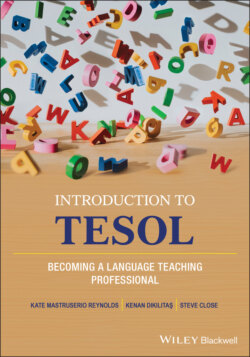Читать книгу Introduction to TESOL - Kate Reynolds - Страница 10
ОглавлениеIntroduction
This textbook is an introduction to the profession of TESOL (teachers of English to speakers of other languages) from a bird’s eye point of view. We wanted newcomers to feel welcomed to the profession through an exploration of the breadth and scope of the field. We believe that newcomers will feel connected through understanding the knowledge base, skills, beliefs, and attitudes that TESOL educators have.
This is a descriptive textbook, which will help any prospective TESOL educator understand the interdisciplinary knowledge base that TESOL professionals share as well as the opportunities and subfields within the discipline. It is meant for educators who are hoping to learn more about TESOL or who are considering entering the field. It covers almost all areas of TESOL in a readable manner for students who are inclined to enter the field or teachers who are already in the field without formalized teacher preparation. It presents an opportunity to understand the numerous specializations and niches in the field that can be explored in TESOL. For example, one could teach first grade students bilingually in Egypt, foreign language instruction of English in Russia, academic second language writing at universities in English-speaking contexts, or research language patterns employed cross-culturally by different genders.
The major goal of this text is to share essential facts while providing basic information about contexts for teaching, our learners and their goals, professional organizations, linguistics, second language acquisition theories, instructional practices, and professional development. It is designed to help those interested in TESOL situate and commence their studies and research, and orient them so they know where to find resources, how to engage in the profession, and how to grow over the course of a career. It spans English as a second language (ESL) and English as a foreign language (EFL) contexts as the authors are experienced teacher educators in both contexts. We hope it helps all readers identify where to enter the profession in ways that are inspiring and interesting.
This book provides multiple perspectives on teaching and learning a second language, and uses language that new TESOLers can understand, thereby building basic knowledge about the field of TESOL. We hope to offer guidance for the newcomer from the perspective of this is what TESOL educators do and why. Not every instructional or assessment practice works for every student in every context, so it is our intention to provide information about the choices educators can make and align them with potential future contexts and learner populations. We intend our guidance to be descriptive of instructional and assessment practices, without prescribing them as the only way to approach these instructions and assessments. We hope that everyone who reads this book will find the ideas suggested to be stimulating. We hope, too, that readers will be creative in their teaching and learning and share their innovations with the field, so it continues to develop in the rich manner it has.
The learning theory that informs our perspectives on learning and teaching is Constructivism. Constructivism is the theory that individuals construct, or transform, their understandings of meanings and concepts through learning experiences (von Glasersfeld, 2005). This language is used throughout the text. However, we recognize that many of the practices, for example, teaching language skills or developing lesson plans, spring from Bloom’s mastery learning model (1976). This text, therefore, is a hybrid of both educational perspectives.
In an odd way, this text is a love letter to a field of study, TESOL, second language learning, and English language learners (ELLs). In total, we have been studying and teaching in the field of TESOL for 80 years. That sort of dedication reveals a deep commitment to our ELLs and teacher candidates as well as the subject, the profession, and the processes involved in principled second language teaching and learning. It is our sincere hope that we convey in this text the wonderful, fascinating complexities and diversity of the field and inspire you to join us to engage professionally as a lifelong teacher-learner. We hope you find your niche within TESOL, so you can be the next generation of TESOL leaders.
References
1 Bloom, B.(1976). Human characteristics and school learning. McGraw-Hill.
2 von Glasersfeld, E.(2005). Introduction: Aspects of constructivism. In C. T. Fosnot(Ed.), Constructivism: Theory, perspectives, and practice (2nd ed.) (pp. 3–7). Teachers College Press.
